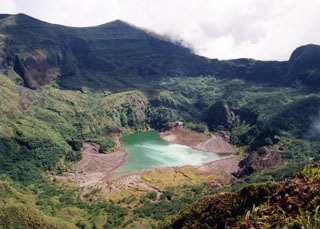Report on Awu (Indonesia) — April 1992
Bulletin of the Global Volcanism Network, vol. 17, no. 4 (April 1992)
Managing Editor: Lindsay McClelland.
Awu (Indonesia) Rapid drop in crater lake level; lithic ejecta surround small new crater
Please cite this report as:
Global Volcanism Program, 1992. Report on Awu (Indonesia) (McClelland, L., ed.). Bulletin of the Global Volcanism Network, 17:4. Smithsonian Institution. https://doi.org/10.5479/si.GVP.BGVN199204-267040
Awu
Indonesia
3.689°N, 125.447°E; summit elev. 1318 m
All times are local (unless otherwise noted)
The crater lake was visited on 11 May, following a sudden drainage of ~80% of the lake (from ~3.5 x 106 m3 to 0.7 x 106 m3) on 1 February. Water temperature was 31.1°C and pH was 2-3, similar to 4 March values (17:02), cooler but more acid than the 36°C and pH 5 measured in February. Fumaroles along the inner N wall of the crater emitted steam that rose 25-40 m and had temperatures of 70-92°C. Active solfataras, with temperatures of 70.6-97.4°C, had left substantial sulfur along the S and E walls. In the SE section of the crater, a deep vent 20 m in diameter produced a thick 50-m-high steam cloud that smelled of sulfur and was accompanied by an audible boiling sound. The presence of lithic ejecta around the vent suggested that it had been formed by a phreatic explosion.
Tectonic and volcanic A-type earthquakes were recorded at the volcano every month during January 1991-January 1992; volcanic A-type events ranged from 2 to 18/month.
Geological Summary. The massive Gunung Awu stratovolcano occupies the northern end of Great Sangihe Island, the largest of the Sangihe arc. Deep valleys that form passageways for lahars dissect the flanks of the volcano, which was constructed within a 4.5-km-wide caldera. Powerful explosive eruptions in 1711, 1812, 1856, 1892, and 1966 produced devastating pyroclastic flows and lahars that caused more than 8000 cumulative fatalities. Awu contained a summit crater lake that was 1 km wide and 172 m deep in 1922, but was largely ejected during the 1966 eruption.
Information Contacts: W. Modjo, VSI; UPI

